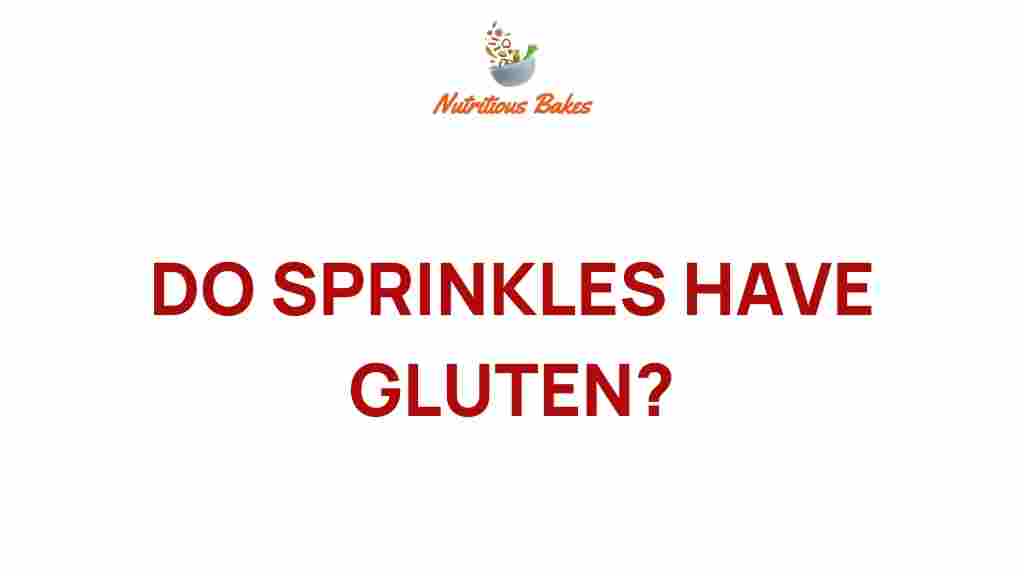The Gluten Dilemma: Are Your Favorite Sprinkles Safe?
Sprinkles are a delightful addition to many desserts, adding a pop of color and a touch of sweetness to cupcakes, cookies, and ice cream. However, if you or someone you know has a gluten intolerance or celiac disease, you may be wondering: are those fun little toppings safe? In this article, we will explore the connection between gluten and sprinkles, examine food allergies related to gluten, and provide you with essential information about ingredient safety when it comes to your favorite dessert toppings.
The Gluten Connection in Sprinkles
Gluten is a protein found in wheat, barley, and rye. It can cause serious health issues for individuals with celiac disease or gluten sensitivity. When it comes to sprinkles, the ingredients used to create these colorful toppings can vary widely. Some sprinkles are made from gluten-containing grains, while others are gluten-free. Understanding food labels and ingredient safety is crucial for anyone with food allergies.
What Are Sprinkles Made Of?
Sprinkles typically consist of the following ingredients:
- Sugar
- Starch (often cornstarch, which is gluten-free)
- Food coloring
- Flavoring agents
- Gelatin or other binding agents
While many of these components are gluten-free, the potential for cross-contamination during manufacturing processes is a concern. This means that even if sprinkles are made without gluten ingredients, they could still be contaminated with gluten through shared equipment or facilities.
Understanding Food Labels and Ingredient Safety
When shopping for sprinkles, it’s essential to read food labels carefully. Here are some key points to consider:
- Gluten-Free Certification: Look for products that are certified gluten-free. This indicates that they have been tested and meet strict gluten-free standards.
- Ingredient List: Check the ingredient list for any gluten-containing components. If you see wheat, barley, or rye, avoid that product.
- Manufacturing Practices: Many companies will note if their products are made in a gluten-free facility or if they are manufactured on shared equipment.
For more detailed information on reading food labels, check out this comprehensive guide.
How to Choose Safe Sprinkles
To ensure you are choosing the right sprinkles for your baking and dessert toppings, follow these steps:
Step 1: Research Brands
Before purchasing sprinkles, do some research on brands that offer gluten-free options. Some popular brands that are known for their gluten-free sprinkles include:
- Wilton
- Sweetapolita
- Funfetti
- Decorating Essentials
Step 2: Read Labels While Shopping
When you’re in the store, don’t hesitate to pick up the packaging and read the labels. Look for gluten-free certifications, and check the ingredient list for any potential allergens.
Step 3: Ask Questions
If you are unsure about a product, don’t hesitate to ask store staff or contact the manufacturer directly. They should be able to provide you with information regarding gluten content and safety.
Common Food Allergies Related to Gluten
Gluten is a common allergen that can trigger a variety of reactions in sensitive individuals. Here are some common food allergies related to gluten:
- Celiac Disease: An autoimmune disorder where ingestion of gluten leads to damage in the small intestine.
- Non-Celiac Gluten Sensitivity: A condition where individuals experience symptoms similar to celiac disease after consuming gluten, but without the intestinal damage.
- Wheat Allergy: A true allergy to wheat, which can cause a range of symptoms from hives to anaphylaxis.
It’s important to be aware of these conditions when choosing sprinkles and other dessert toppings, as cross-contamination can be a serious issue.
Baking with Gluten-Free Sprinkles
If you’re planning to bake with gluten-free sprinkles, here are some tips to ensure a successful outcome:
Tip 1: Use Gluten-Free Recipes
When baking, make sure to use gluten-free recipes that specifically call for gluten-free ingredients. This will help prevent any unintentional gluten exposure.
Tip 2: Store Separately
Keep gluten-free sprinkles stored separately from gluten-containing products to avoid cross-contamination.
Tip 3: Test for Allergens
If you’re baking for someone with food allergies, consider testing a small amount of the sprinkles in a safe environment before serving.
Troubleshooting Common Issues
Even with careful planning, issues can arise when using sprinkles in your baking. Here are some common problems and solutions:
Problem 1: Sprinkles Melting in the Oven
Sometimes sprinkles can melt or lose their color when baked. To prevent this, add sprinkles to the top of your baked goods just before they go into the oven or sprinkle them on after baking.
Problem 2: Cross-Contamination
If you suspect cross-contamination, stop using that product immediately and switch to a certified gluten-free brand. Always prioritize safety.
Problem 3: Allergic Reactions
If you or someone consuming your baked goods has an allergic reaction, seek medical attention immediately. Always err on the side of caution when it comes to food allergies.
Conclusion
The gluten dilemma surrounding sprinkles is one that many bakers and dessert lovers face. With the right knowledge about gluten, ingredient safety, and food labels, you can enjoy sprinkles in your baking without worry. Always choose certified gluten-free sprinkles and remain vigilant about cross-contamination.
As we’ve explored in this article, understanding the ingredients in your favorite dessert toppings is crucial for ensuring safety for those with food allergies. The world of confectionery can be fun and safe with the right choices!
For more information on food allergies and gluten-free living, visit this resource.
This article is in the category Ingredients and created by NutritiousBakes Team
